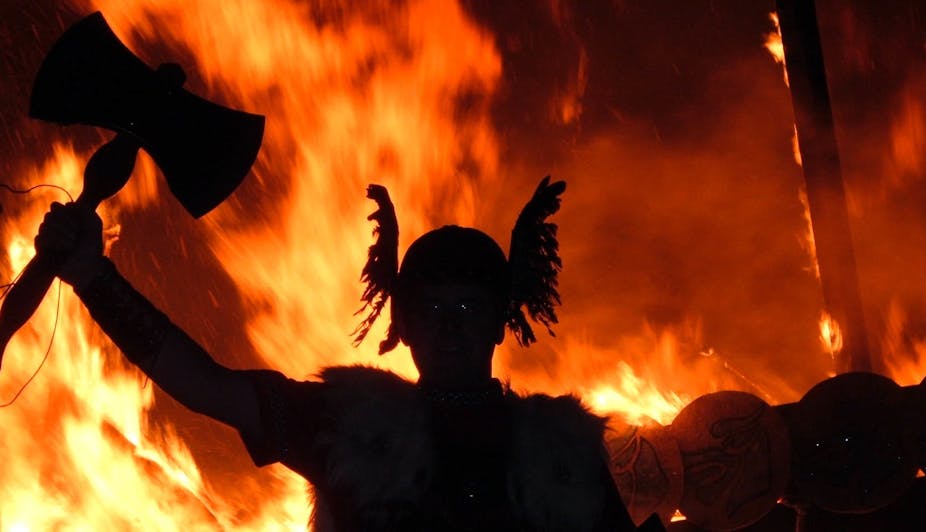“Viking!” was the word retired businessman Derek McLennan shouted to metal detector enthusiasts standing in a field in Dumfriesshire in south-west Scotland in September. He had just uncovered a hoard of gold, silver, glass and enamel objects with an estimated value of £1m. These were broadly the details that attracted the most media attention. Yet their discovery also provides fascinating insights into the Viking age.
It is hard to be precise about the contents of the discovery at this stage. Part of it remains sealed within an elaborately decorated vessel. Each of the objects needs to be painstakingly conserved as well as identified. Initial work indicates that there are more than 100 objects drawn together from different areas of Viking settlement and raiding: from Ireland, Scandinavia and the Carolingian empire in latter-day France, Benelux and Germany.
An inventory of treasure
A few pieces stand out from initial reports. These include the Carolingian silver alloy vessel, a silver cross, a very elegant golden pin in the shape of a bird and silver arm-rings stamped with distinctive saltire and linear designs. The styles and forms of the objects suggest they were probably deposited together in the late ninth or tenth century.

From Istanbul to Greenland, Vikings traded through barter and in bullion, which explains the mixed nature of the hoard. Items of gold or silver were traded by weight. The arm-rings could be worn like a money belt (or for show) and then chopped up and traded when convenient. Other items like the ornate golden pin could have been prized for its artistic merits as well as weight. It might have intended for barter or gift giving. The hoard also includes many Hiberno-Scandinavian ingots.
The presence of a Christian cross suggests that some items were looted as well as traded. But as Viking conversion to Christianity is attested from the late ninth century, we cannot be sure that the people who accumulated this wealth were pagans. And if the hoard was buried in the ground for safety, why wasn’t it recovered? Did the hapless owners lose track of its location or did they die suddenly or in another land and their treasure was lost? Hoards are a common phenomenon across the Viking world and they may be indicators of political instability as well as of power and wealth.

Exploration super-highway
What were Vikings doing in Dumfriesshire at this time? While the area is not a major highway for commerce in the present day, if we go back 1,000 years, things looked rather different. The Irish Sea was a key route for Viking ships sailing between Scandinavia, continental Europe and Ireland. Vikings first raided the western margins of Scotland in the closing years of the eighth century. By the late ninth century they had established settlements in the Hebrides and the Firth of Clyde and established ports along the eastern coasts of Ireland, most famously at Dublin. The north-Solway coast, much of which is Dumfriesshire, was drawn into this Viking trading network.

The riches flowing into the Irish Sea region attracted Vikings to trade and settle in this area north of the Solway. Another hoard that was first uncovered in 1912 was deposited at Talnotrie in Kirkcudbright around 875, not very far from the new site (whose exact location has not yet been revealed). The contents of the Talnotrie find included two fragments of Kufic coins and a fragment of a Frankish coin known as a denier, all of which had probably passed through Vikings’ hands. Chance finds of Viking metalwork in the area include a decorated lead weight from Gallaberry near Dumfries and another weight from Lochmaben, four miles west of Lockerbie. There are also Viking pagan burials in the area.
A cremation burial accompanied by a silver arm-ring and an amber bead was discovered in Crossmichael near Castle Douglas in the 18th century. A burial of a Viking warrior was recovered from St Cuthbert’s churchyard in Kirkcudbright, which included a sword, a ring-pin and a bead (suggesting that jewellery as well as weaponry was highly prized in Valhalla). Another warrior burial was found at Carronbridge, north of Dumfries, including a sword, penannular brooch and sickle. The presence of a sickle suggests that Vikings came to the region to farm as well as to fight or trade.

Traces that remain
The place-name evidence from Dumfriesshire presents the region as a cultural crossroads, with names in English, Norse, Gaelic and the old language of Brittonic. Viking migrants settled from north-west England, Ireland and western Scotland, probably as an elite group rather than in a mass migration. The village of Tinwald in Dumfriesshire comes from the Old Norse word “þing” (or assembly, council, gathering). It is a local assembly site, suggesting that Viking settlers exercised law and government in a similar way to the Viking homelands or the Isle of Man (where the Viking-age assembly or “thing” site at Tynwald is still the site of the local parliament).
There is still so much we don’t know about the Vikings from that area. We have no written sources, so we have to rely on place names and archaeological discoveries for almost everything. We don’t even know who ruled Dumfriesshire at the time, for example. We may learn more as the new discovery is properly studied in the coming months, but certainly it has challenged previous assumptions that the area was not heavily influenced by Vikings.
What we do know is that the Viking age was a period of radical political, economic and cultural change in Britain and Ireland. The cluster of finds including hoards, burials and settlements in the lands surrounding the Irish Sea highlight its role as a “Viking lake”. In those days the sea was a route for communication rather than a barrier. The new discoveries from Dumfriesshire show that immigration and international trade are not modern phenomena. As we continue to piece together our distant past, it is a reminder that some things have changed less than we might imagine.

